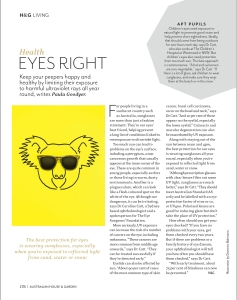Summer Lovin’ – protecting your families eyes
Protection from UV rays required all year round
The sun is not just something to consider in Summer – our eyes need protection from it’s harmful UV rays all year round. Paediatric ophthalmologist Dr Caroline Catt has was recently interviewed by Paula Goodyer for House & Garden magazine’s Health feature. Dr Catt was asked about the importance of protecting our eyes & our children’s eyes from the sun’s harmful UV rays & the issues that can arise. Click the image below to read the article in full.
Extended exposure to the sun’s UV rays has been linked to several eye conditions including Cataracts, macular degeneration, pterygia, photoconjunctivitis and photokeratitis that can cause temporary vision loss. There have also been associations made between some eye cancers and life long exposure to the sun – a common location where Basal Cell Carcinomas are detected are the eyelids.
Photokeratitis is an inflammation of the cornea, while photoconjunctivitis refers to inflammation of the conjunctiva (the membrane that lines the inside of the eyelids and eye socket). Cataract is the leading cause of blindness in the world & while considered a normal process of the aging of our lens, they appear to be enhanced by exposure to UVB. Pterygium is a benign growth of the conjunctiva & is viewed as a cosmetic blemish. These can interfere with the tear film of the eye & grow over the cornea which can cause discomfort. If problematic surgery to remove pterygia is possible.
During human evolution a number of mechanisms have evolved to protect this very sensitive organ of ours against harmful effects of the sun’s UV rays:
- Anatomically the eye is recessed within the head and shielded well by the brow ridge, the eyebrows and the eyelashes.
- Constriction of the pupil
- Closure of the eyelids and the squinting reflex minimize the penetration of the sun’s rays into the eye
These mechanisms are activated by bright visible light and not by UV radiation – but on a cloudy day UV radiation exposure may still be high. Therefore, the effectiveness of these natural defences in protecting against UV damage is limited. Dr Catt feels the best approach to protecting ourselves against the sun is commonsense; “A hat and sunscreen are non-negotiable” says Dr Catt. “If there is a lot of glare, ask children to wear sunglasses and make sure they wear them at the beach or in the snow”.


